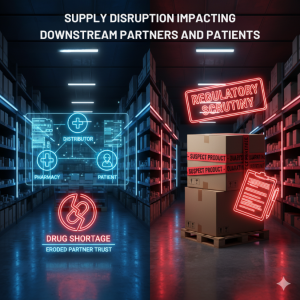For wholesale distributors, a significant, non-negotiable shift occurred on August 27, 2025. The extended period of “enforcement flexibility” officially ended. This isn’t just a regulatory formality; it’s a fundamental, permanent change in how the Drug Supply Chain Security Act (DSCSA) is enforced, particularly regarding how wholesalers receive and handle inventory.
The FDA’s signal is clear: the era of paper records, PDFs, and manual data fixes is over. The expectation is now 100% electronic, interoperable, and serialized data exchange. This transition represents the final, most crucial barrier to securing the U.S. pharmaceutical supply chain.
What does this mean for your daily operations? Any product that arrives at your dock without complete, accurate, and electronic serialized data (specifically, EPCIS data—Electronic Product Code Information Services) is no longer a minor clerical issue. It’s now classified as “suspect product” and, critically, must be immediately quarantined. This quarantine mandate acts as an impenetrable firewall, protecting the integrity of the supply chain while directly challenging the operational efficiency of every wholesale distributor.
This isn’t a theoretical fine or a slap on the wrist. This is a direct operational and financial nightmare that is already impacting business hard across three major vectors.
1. Stalled Shipments: Your Revenue, Locked on the Dock
The most immediate and painful consequence of an EPCIS data mismatch is the forced quarantine. When product is quarantined, it can’t move. It sits there, untouched, unusable. This means inventory you’ve already purchased, ready to be distributed for urgent patient needs, is now stuck. Your revenue is literally locked up on the receiving dock, unable to generate sales.
The impact goes far beyond the delayed payment for the product itself.

- Tied-Up Capital: The value of the product is illiquid, sitting in storage rather than cycling through sales. For high-value oncology or specialty drugs, this can be millions in non-performing assets.
- Operational Drag: You incur direct storage fees (especially for temperature-sensitive products), additional labor costs for handling and re-handling, and the staggering opportunity cost of not being able to sell that product to your downstream partners when they need it.
- The Velocity Hurdle: Wholesalers operate on thin margins and high velocity. A consistent flow of product is essential. Quarantines choke this flow, effectively reducing your overall distribution capacity and disrupting key performance indicators (KPIs) tied to delivery speed and accuracy.
The Cost: The industry consensus is that even a small percentage of data errors (e.g., 2-3% of shipments) can translate into massive financial losses, potentially costing the supply chain billions annually in stalled shipments, lost sales, and resolution efforts.
2. Manual Fixes: The Astronomical Cost of Exceptions
The moment a product is quarantined due to missing or incorrect data, an exception has been created. Every single exception triggers an expensive and time-consuming manual process that directly erodes profitability.

The Exception Handling Cascade:
- Investigation: Staff must manually reconcile the physical product (the 2D barcode scan) against the electronic data (the EPCIS file). They cross-reference purchase orders, shipping manifests, and internal systems to pinpoint the discrepancy.
- Supplier Communication: The distributor must contact the manufacturer or prior trading partner to track down the correct electronic data. This often involves multiple emails, phone calls, and complex data exchange outside of automated systems.
- Data Remediation: Once the correct data is obtained, it must be uploaded, matched to the quarantined product, and reconciled in the distributor’s system before the product can be released. The FDA expects that these errors or discrepancies should be resolved quickly, generally aiming for resolution within three business days. Every day past this soft deadline increases risk and cost.
The Cost: These manual processes divert highly-paid, skilled staff—often in Quality Assurance or IT roles—from other critical tasks. They are incredibly time-consuming and prone to human error, which can introduce new compliance risks. The cost of reconciling data for every exception can quickly become astronomical, turning a profit-generating product line into a margin-eating liability. A high volume of exceptions is a sign that the entire inbound process is fundamentally broken and reliant on an unsustainable, reactive model.
3. Supply Disruption: Impacting Downstream Partners and Patients
The DSCSA was enacted to protect the patient. When your shipments are stalled, it’s not just your business that feels the pinch—the consequences ripple throughout the healthcare system.

- Eroded Partner Trust: Downstream partners—pharmacies, hospitals, and clinics—rely on you for timely and accurate deliveries of life-saving and essential medications. Frequent delays from quarantined products can damage your hard-earned reputation as a reliable supplier. In a highly competitive industry, losing the trust of a major health system or pharmacy chain can lead to long-term contract losses.
- Patient Safety and Access: The ultimate risk. Quarantines delay time-sensitive drugs, leading to drug shortages at the dispenser’s end. This directly compromises patient access to essential medications, whether it’s an antibiotic for a child or a critical cancer treatment. From the FDA’s perspective, the inability to verify a product’s legitimacy via EPCIS data means the drug is suspect—and preventing a suspect product from reaching a patient is paramount, even if it causes a temporary shortage.
- Regulatory Scrutiny: Repeated issues with data quality and quarantines can flag your organization for increased regulatory scrutiny. Proactively managing a high volume of quarantined product is a necessary evil, but having a low exception rate is the clear goal to maintain your “authorized trading partner” status in good standing.
The Cost: Beyond the immediate operational headache, frequent disruptions can damage your reputation, erode trust with your partners, and ultimately jeopardize patient safety.
Is Your EPCIS Data Reconciliation Process Robust?
This new era of full DSCSA enforcement means you can no longer “hope for the best” or rely on last-minute, reactive fixes when it comes to inbound data. The focus must shift from a “fire extinguisher” reaction—fixing problems after the product is quarantined—to a “fire prevention” strategy based on automation and data integrity.
You need a truly robust, automated EPCIS data reconciliation process that can:
- Pre-Receipt Validation: Utilize systems that receive and validate the EPCIS data before the physical product arrives at the dock. This allows for communication with the supplier while the product is still in transit, potentially preventing a quarantine altogether.
- Automated Discrepancy Identification: Automatically scan and reconcile the physical product’s serialized ID against the expected EPCIS file upon receipt. The system should instantaneously identify mismatches, whether they relate to GTINs, serial numbers, lot numbers, or expiration dates.
- Immediate Flagging and Triage: Flag exceptions immediately, not hours later. Modern systems should automatically categorize the severity of the exception (e.g., Data Missing vs. Data Mismatched vs. Suspect Product) and initiate the appropriate quarantine workflow.
- Streamlined Resolution Workflow: Provide a single, auditable platform to manage communication and data exchange with suppliers. The goal is to minimize manual intervention by using standardized templates and communication protocols for data requests and remediation.
- Proactive Reporting and Analytics: Use the exception data to create a supplier scorecard. If a manufacturer is consistently sending inaccurate data, your system should flag them, allowing you to proactively communicate a need for improvement, or even prioritize the manual scanning of their shipments over others.
The Road Ahead: From Compliance to Operational Excellence
The August 27, 2025, deadline marks the end of a long journey toward an electronic, secure drug supply chain, but for wholesalers, it is only the beginning of a new operational reality. Full compliance is now table stakes; operational excellence in exception handling is the new competitive differentiator.
The wholesale distributor sits at the nexus of the supply chain, acting as the primary gatekeeper for the flow of products to the patient. By viewing the quarantine mandate not as a burden but as a necessary firewall, companies can harden their systems, reduce manual costs, and solidify their position as the reliable, authorized trading partner of choice.
